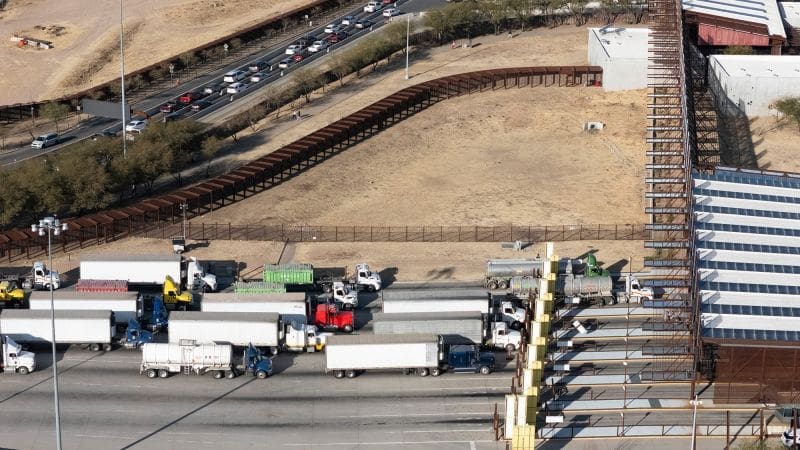Businesses along the US-Mexico border are bracing for potential economic upheaval as President Trump’s proposed tariffs loom. There’s palpable unease among companies about the pending 25% tariffs. This uncertainty has already put crucial spending and hiring decisions on hold, with impacts that could reverberate across industries.
The 2,000-mile region, home to bustling cities like San Diego and El Paso, is a commercial hub. Yet, these tariffs threaten to stifle economic growth, sparking fears of recession. Many are concerned about the local and broader economic implications, highlighting the stakes for this crucial area near the border.
Economic Impacts in Border Regions
The US-Mexico border region is a vital economic area, home to numerous industries such as manufacturing and transportation. However, the proposed 25% tariffs could severely disrupt this balance. Many businesses rely heavily on cross-border trade, and any increase in costs can have ripple effects. Christopher Erickson, an economics professor, suggests that such tariffs could tip these communities into recession.
Potential Job Losses
Job security is under threat, especially in the Paso Del Norte area, where the auto industry is integral. Jon Barela, CEO of Borderplex Alliance, points out that up to 100,000 jobs could be at risk if tariffs are imposed, especially given the automotive supply chain’s complex nature.
The tariffs would significantly increase the cost of assembling vehicles, which may force companies to reconsider their operations. This, in turn, could lead to a reduction in workforce as businesses strive to manage costs.
Such economic pressure may push firms to delay expansion plans and halt new hires, adding to unemployment woes. Concerns are mounting over how this could further exacerbate economic vulnerabilities in the region.
Trade Relations Under Strain
Mexico, a key trading partner, could face its own economic challenges, affecting the US in return. With 80% of Mexican exports heading north, tariffs could lead to a recession in Mexico, impairing cross-border economic exchanges.
Such a downturn would not only impact Mexican businesses but would also reduce spending by Mexican nationals in the US, affecting local economies along the border like San Diego.
The North American Free Trade Agreement initially strengthened economic ties. Now, proposed tariffs threaten to unravel these benefits, putting years of economic collaboration at stake.
Effects on Local Businesses
Local enterprises depend greatly on cross-border interaction, creating intertwined economies that could suffer due to tariff-induced disruptions.
McAllen, Texas, highlighted for its strong sales tax collection, could see reduced revenues. Economic strain on Mexican shoppers and tourists would curtail spending, further impacting local businesses.
Elizabeth Suarez from the McAllen Chamber of Commerce notes that any decrease in cross-border patronage can significantly impact sales tax revenue, underlining the community’s economic dependency.
Broader Economic Consequences
The overall impact of tariffs extends beyond just border regions. Importers across the US face higher costs, potentially leading to increased prices for consumers.
Additionally, tariffs might stifle economic growth by driving up business costs. This sentiment is echoed by analysts who argue that such measures could detract from broader economic stability.
Businesses may choose to either absorb the added costs or pass them on to consumers, both of which could negatively affect market dynamics and consumer spending.
Strategic Delays in Business Decisions
Facing unsteady horizons, companies are forced to delay key decisions. Such uncertainty stalls strategic initiatives critical for growth.
Like Alan Russell of Tecma Group expressed, “Uncertainty is the enemy of commerce,” highlighting how the lack of clarity impacts immediate business strategies.
Companies must navigate a nebulous environment, and any prolonged uncertainty could hamper innovation and operational efficiency.
Consumer Impacts From Tariff Price Increases
Consumers, already sensitive to price changes, may find tariff-induced hikes burdensome. This scenario could reduce demand for imported goods.
With potential increases in the cost of everyday goods, households may have to alter spending habits, affecting retailers.
Such shifts in consumer behavior could feed back into the economy, creating a chain reaction that dampens economic momentum further.
Government and Policy Responses
Responses from policymakers and economists suggest a need for balanced trade solutions. Efforts are required to mitigate potential adverse effects on the economy.
While some advocate for renegotiation and dialogue, others stress the importance of preparing for possible repercussions.
Local and national responses could shape the outcome of these tariff discussions, creating either relief or further challenges for businesses and consumers.
Conclusion: Preparing for an Uncertain Future
A cautious approach is essential as the region could face significant challenges. Companies must prepare for varying outcomes.
While the final decision on tariffs remains, the border region must weigh potential economic burdens against strategic planning to navigate future complexities.
The looming threat of tariffs is a pressing concern for border economies. Regions reliant on cross-border trade must brace for potential setbacks.
As the situation unfolds, businesses and policymakers must focus on maintaining economic stability amidst shifting trade dynamics.








